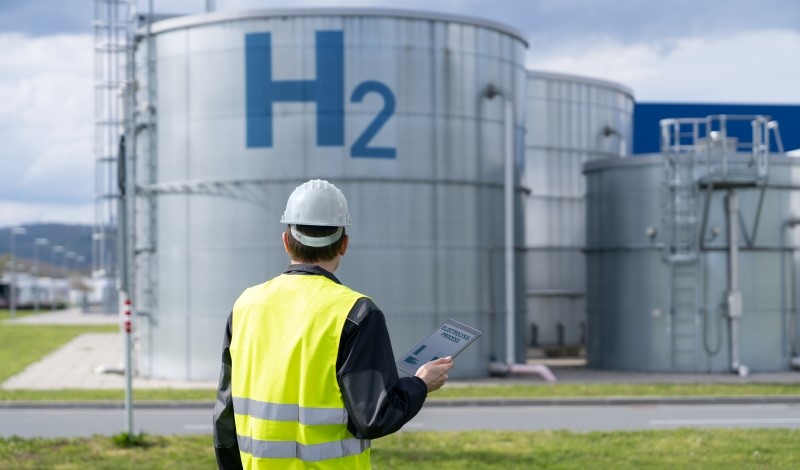
Scholars disagree on whether hydrogen is a viable replacement for fossil fuels.
To combat climate change, many countries are turning to hydrogen as a potential clean energy source. But some scientists argue that hydrogen energy’s effects on global warming depend on which methods are used to produce it and which industries it is used for.
Hydrogen is most frequently used as an energy source in the oil refining and chemicals industries. But some argue that it could potentially solve the emission effects of burning fossil fuels if used more broadly.
Currently, most energy is obtained from burning fossil fuels. Doing so is bad for the environment because, when burned, fossil fuels release carbon dioxide and other greenhouse gases into the atmosphere and contribute to global warming. As global temperatures continue to rise, there will be an “increase in the frequency and severity of heat extremes, heavy rainfall events, and regional droughts,” all of which threaten human life.
Hydrogen energy could be a preferable alternative to fossil fuels because it does not release any carbon dioxide or other greenhouse gases when being converted to energy. Consequently, hydrogen energy could potentially have no negative effects on the environment.
But to be environmentally friendly, hydrogen energy must be produced in a “clean” way because carbon dioxide is a byproduct of some production methods. In addition, hydrogen energy is not presently cost effective for some industries, and thus would need to be selectively used. Finally, hydrogen must be carefully contained, as hydrogen atoms cause indirect warming effects if they leak into the atmosphere.
To determine how “clean” hydrogen is, scholars use a color-coded system based on the method of production used. Hydrogen produced from natural gas with the aid of carbon capture, usage, and storage (CCUS) technology is considered “blue” hydrogen, and hydrogen created from renewable energy and water is considered “green” hydrogen. Without CCUS technology, hydrogen generated with fossil fuels is not considered clean because it releases carbon dioxide during production. Consequently, its warming effects outweigh its potential benefits.
Effective implementation of hydrogen energy requires its use in hard-to-abate industries, such as steel and cement production. The deployment of hydrogen also consumes more energy than most alternatives, such as wind or solar, making it ineffective for daily consumer usage and some commercial businesses.
Furthermore, the viability of hydrogen energy as a solution to climate change depends on how much is leaked throughout its use. One group of researchers found that hydrogen, when leaked into the atmosphere, has a greater warming effect than had previously been recorded due to an oversight in the way warming effects are traditionally calculated. Green hydrogen leakage could undercut the benefits of the generated hydrogen, and leakage from blue hydrogen systems could harm the environment more than current fossil fuel systems if both the hydrogen and CCUS storage systems leak. As a result, some scientists suggest that hydrogen should be used close to its production site to reduce the risks of leakage over long-distance travel.
This week’s Saturday Seminar examines existing hydrogen energy regulations and hydrogen’s potential as an energy alternative to fossil fuels.
- In an article in the Journal of World Energy Law & Business, Kim Talus of the Association of International Energy Negotiators and practitioner Maxwell Martin discuss the national hydrogen roadmap. Talus and Martin explain that the Infrastructure Investment and Jobs Act directs the S. Department of Energy to develop a “‘technologically and economically feasible’ strategy and roadmap for the United States to facilitate widescale production, processing, delivery, and use of clean hydrogen.” The authors describe the roadmap as a positive development toward achieving a “50–52 percent reduction from 2005 levels” in greenhouse gas pollution by 2030. A hydrogen economy is feasible if the United States can maintain its current pace toward greenhouse gas emission reduction, emphasize Talus and Martin.
- In a Resources for the Future report, Alan Krupnick and Aaron Bergman discuss two tax provisions under the Inflation Reduction Act that aim to subsidize clean hydrogen production. The authors explain that the Act provides a new tax credit valued on a business’s “aggregate quantity of greenhouse gas emissions” and increases the value of an earlier tax credit for carbon sequestration—a type of CCUS technology used in blue hydrogen production. Krupnick and Bergman argue that both tax credits can help to reduce the price difference between clean hydrogen and more carbon-intensive alternatives. One desired effect of creating tax incentives is to decarbonize other sectors, especially industrial and transportation sectors, Krupnick and Bergman observe.
- Self-regulation of the clean hydrogen industry could foster innovation and growth, claim Daniel Walters of the Texas A&M School of Law and Hannah Wiseman of Penn State University in an article in the Law and Economics Center at George Mason University Scalia Law School Research Paper Series. Walters and Wiseman argue that government regulation of the clean hydrogen industry may not properly balance predictability and flexibility, both of which are important for continued growth. Furthermore, disputes may arise regarding which agency has jurisdiction, the authors point out. Self-regulation would allow industry experts to create standards that promote consumer safety and commercial growth while allowing government oversight to fill any remaining regulatory gaps, argue Walters and Wiseman.
- In a report on decarbonization efforts, the Government Accountability Office (GAO) identified the high cost of technologies used to convert hydrogen into power as a challenge to scaling up such technologies. GAO explains that converted materials cost more to produce and buy than conventional fuel sources, and warns that clean hydrogen is necessary to prevent an increase in carbon dioxide emissions. Accordingly, GAO proposes that policymakers develop “clean hydrogen hubs”—technologies that convert carbon dioxide emitted from creating hydrogen into useful products such as ethanol, plastics, or sustainable aviation fuel. GAO points out that selling these carbon dioxide-based products could offset the high production costs of hydrogen energy.
- In a recent article in Sustainability, Wenting Cheng of Australian National University and Sora Lee of La Trobe University examine the regulatory approaches to hydrogen energy in 28 countries. Cheng and Lee find that only four countries—Chile, Italy, New Zealand, and Spain—have strict regulations that promote renewable hydrogen as a complete replacement for conventional energy sources. Cheng and Lee classifyS. regulations as among the least stringent because the United States uses a market-based regulatory approach, which the authors argue does not sufficiently promote the phasing-out of fossil fuels. Cheng and Lee claim that renewable hydrogen can only replace fossil-fuel hydrogen if doing so is economically feasible, a goal made more difficult by permissive regulations.
- In an article in the Florida International University Law Review, Mario Loyola of Florida International University argues that hydrogen energy remains an insufficient solution to climate change because CCUS has not been proven viable. Loyola explains that the S. Environmental Protection Agency (EPA) recently published a proposed rule that aims to restrict greenhouse gas emissions from “fossil fuel-fired electric generating units” by designating green hydrogen as the model source of renewable energy under the Clean Air Act. But the author argues that to do so, EPA must show that green hydrogen is a feasible and cost effective source of energy. Loyola concludes that because these conditions have not been met, EPA’s proposed rule is not feasible and may be unlawful.



